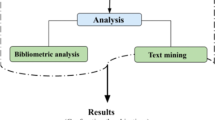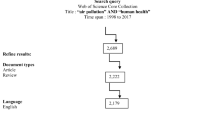Abstract
Many scholars have worked to solve the widespread problems associated with air pollution especially in developing countries. So, there is a huge bulk of research output in this field that should be classified to determine the next steps and finding out research gaps. Hence, in this study, the scientometric approach was performed by CiteSpace V to draw the trends and signify issues in the research area. Based on the search in ISI Web of Science database, 25,363 documents were retrieved for air pollution in developing countries. The documents were analyzed for co-authorship, countries collaboration, ISI Web of Science categories co-occurrence, keyword co-occurrence, and institutional collaboration. The data showed the published studies had an upward trend over the years. By considering the number of citations, China plays an important role in air pollution research in developing countries, and the USA is the top country with the potential to change the structure of the network. Along with the developing countries, developed countries have also played a serious role in advancing research in this field. The trend of the studies has shown that research trends in early years tend to pure environmental studies, and in recent years, it has shifted to areas like monitoring, management, and biodiversity conservation. Keyword co-occurrence showed sulfur dioxide with a duration of 22 years is one of the most important issues in studies of air pollution in developing countries. Among the institutes, the University of Sao Paulo and Harvard University have made greater efforts to investigate air pollution in developing countries. Nanjing University of Information Science& Technology had the highest frequency in a short period. Overall, this work provides a quantitative, visual, and large-scale review of the majority of publications on ‘air pollution in developing countries’ that may be important to researchers, practitioners, sponsors, and any individual/ institution concerned about air pollution.





Similar content being viewed by others
References
Aiken AC, de Foy B, Wiedinmyer C, DeCarlo PF, Ulbrich IM, Wehrli MN, Szidat S, Prevot ASH, Noda J, Wacker L, Volkamer R, Fortner E, Wang J, Laskin A, Shutthanandan V, Zheng J, Zhang R, Paredes-Miranda G, Arnott WP, Molina LT, Sosa G, Querol X, Jimenez JL (2010) Mexico city aerosol analysis during MILAGRO using high resolution aerosol mass spectrometry at the urban supersite (T0) - part 2: analysis of the biomass burning contribution and the non-fossil carbon fraction. Atmos Chem Phys 10(12):5315–5341. https://doi.org/10.5194/acp-10-5315-2010
Atash F (2007) The deterioration of urban environments in developing countries: mitigating the air pollution crisis in Tehran, Iran. Cities 24(6):399–409. https://doi.org/10.1016/j.cities.2007.04.001
Bruce N, Perez-Padilla R, Albalak R (2000) Indoor air pollution in developing countries: a major environmental and public health challenge. Bull World Health Organ 78(9):1078–1092
Chen C (2012) Turning points: the nature of creativity. Springer Science & Business Media
Chen C (2005) The centrality of pivotal points in the evolution of scientific networks. In: Proceedings of the 10th international conference on Intelligent user interfaces, pp. 98–105
Chen C, Chen C (2003) Mapping scientific frontiers. Springer
Cobo MJ, López-Herrera AG, Herrera-Viedma E, Herrera F (2011) Science mapping software tools: review, analysis, and cooperative study among tools. J Am Soc Inf Sci Technol 62(7):1382–1402
Dhital S, Rupakheti D (2019) Bibliometric analysis of global research on air pollution and human health: 1998–2017. Environ Sci Pollut Res 26(13):13103–13114. https://doi.org/10.1007/s11356-019-04482-x
Di D, Zhang L, Wu X, Leng R (2019) Long-term exposure to outdoor air pollution and the risk of development of rheumatoid arthritis: a systematic review and meta-analysis. Semin Arthritis Rheum 50:266–275. https://doi.org/10.1016/j.semarthrit.2019.10.005
Elliott S, Shen M, Blake DR, Lu R, Russell AG, Kao CYJ, Streit GE, Zhao XP, McCreary EI, Rowland FS, Brown MJ, Turco RP (1997) Atmospheric effects of the emerging mainland Chinese transportation system at and beyond the regional scale. J Atmos Chem 27(1):31–70. https://doi.org/10.1023/a:1005726818613
Faiz A (1993) Automotive emissions in developing countries-relative implications for global warming, acidification and urban air quality. Transport Res A Pol 27(3):167–186. https://doi.org/10.1016/0965-8564(93)90057-R
Faiz A, De Larderel JA (1993) Automotive air pollution in developing countries: outlook and control strategies. Sci Total Environ 134(1):325–334. https://doi.org/10.1016/0048-9697(93)90362-A
Feng J, Cavallero S, Hsiai T, Li R (2020) Impact of air pollution on intestinal redox lipidome and microbiome. Free Radic Biol Med. https://doi.org/10.1016/j.freeradbiomed.2019.12.044
Fotourehchi Z (2016) Health effects of air pollution: an empirical analysis for developing countries. Atmos Pollut Res 7(1):201–206. https://doi.org/10.1016/j.apr.2015.08.011
Graber M, Mohr S, Baptiste L, Duloquin G, Blanc-Labarre C, Mariet AS, Giroud M, Béjot Y (2019) Air pollution and stroke. A new modifiable risk factor is in the air. Rev Neurol 175(10):619–624. https://doi.org/10.1016/j.neurol.2019.03.003
Hendryx M, Luo J, Chojenta C, Byles JE (2019) Air pollution exposures from multiple point sources and risk of incident chronic obstructive pulmonary disease (COPD) and asthma. Environ Res 179:108783. https://doi.org/10.1016/j.envres.2019.108783
Huang W, Cai L, Dang H, Jiao Z, Fan H, Cheng F (2019) Review on formation mechanism analysis method and control strategy of urban haze in China. Chin J Chem Eng 27(7):1572–1577. https://doi.org/10.1016/j.cjche.2018.08.016
Idrees Z, Zheng L (2020) Low cost air pollution monitoring systems: a review of protocols and enabling technologies. J Ind Inf Integr 17:100123. https://doi.org/10.1016/j.jii.2019.100123
Kasdagli M-I, Katsouyanni K, Dimakopoulou K, Samoli E (2019) Air pollution and Parkinson’s disease: a systematic review and meta-analysis up to 2018. Int J Hyg Environ Health 222(3):402–409. https://doi.org/10.1016/j.ijheh.2018.12.006
Li P, Xin JY, Wang YS, Wang SG, Li GX, Pan XC, Liu ZR, Wang LL (2013) The acute effects of fine particles on respiratory mortality and morbidity in Beijing, 2004-2009. Environ Sci Pollut Res 20(9):6433–6444. https://doi.org/10.1007/s11356-013-1688-8
Li C, Wu K, Wu J (2018) Correction to: a bibliometric analysis of research on haze during 2000–2016(Environmental Science and Pollution Research, (2017), 24, 32, (24733-24742), 10.1007/s11356-017-0440-1). Environ Sci Poll Res 25(15):15268. https://doi.org/10.1007/s11356-017-0741-4
Liu F, Chen G, Huo W, Wang C, Liu S, Li N, Mao S, Hou Y, Lu Y, Xiang H (2019) Associations between long-term exposure to ambient air pollution and risk of type 2 diabetes mellitus: a systematic review and meta-analysis. Environ Pollut 252:1235–1245. https://doi.org/10.1016/j.envpol.2019.06.033
Meira LH, de Mello CA, Castro YM, Oliveira LK, Nascimento COL (2020) Measuring social effective speed to improve sustainable mobility policies in developing countries. Transp Res D 78:102200. https://doi.org/10.1016/j.trd.2019.12.002
Olawumi TO, Chan DWM (2018) A scientometric review of global research on sustainability and sustainable development. J Clean Prod 183:231–250. https://doi.org/10.1016/j.jclepro.2018.02.162
Osareh F (1996) Bibliometrics, citation analysis and co-citation analysis: a review of literature I. Libri 46(3):149–158
Oudin A (2020) Short review: air pollution, noise and lack of greenness as risk factors for Alzheimer’s disease- epidemiologic and experimental evidence. Neurochem Int 134:104646. https://doi.org/10.1016/j.neuint.2019.104646
Sathaye J, Tyler S, Goldman N (1994) Transportation, fuel use and air quality in Asian cities. Energy 19(5):573–586. https://doi.org/10.1016/0360-5442(94)90053-1
Song Y, Liu B, Chen X, Liu J (2020) Atmospheric pollution mapping of the Yangtze river basin: an AQI-based weighted co-word analysis. Int J Environ Res Public Health 17(3). https://doi.org/10.3390/ijerph17030817
Sun F, Dai Y, Yu X (2017) Air pollution, food production and food security: a review from the perspective of food system. J Integr Agric 16(12):2945–2962. https://doi.org/10.1016/S2095-3119(17)61814-8
Sweileh WM, Al-Jabi SW, Zyoud SH, Sawalha AF (2018) Outdoor air pollution and respiratory health: a bibliometric analysis of publications in peer-reviewed journals (1900 - 2017). Multidiscip Respir Med 13(1):15. https://doi.org/10.1186/s40248-018-0128-5
Wang H, Fu Z, Lu W, Zhao Y, Hao R (2019a) Research on sulfur oxides and nitric oxides released from coal-fired flue gas and vehicle exhaust: a bibliometric analysis. Environ Sci Pollut Res 26(17):17821–17833. https://doi.org/10.1007/s11356-019-05066-5
Wang X-C, Klemeš JJ, Dong X, Fan W, Xu Z, Wang Y, Varbanov PS (2019b) Air pollution terrain nexus: a review considering energy generation and consumption. Renew Sust Energ Rev 105:71–85. https://doi.org/10.1016/j.rser.2019.01.049
Yang Z, Hao J, Huang S, Yang W, Zhu Z, Tian L, Lu Y, Xiang H, Liu S (2020) Acute effects of air pollution on the incidence of hand, foot, and mouth disease in Wuhan, China. Atmos Environ:117358. doi: https://doi.org/10.1016/j.atmosenv.2020.117358
Zhao X (2017) A scientometric review of global BIM research: analysis and visualization. Autom Constr 80:37–47. https://doi.org/10.1016/j.autcon.2017.04.002
Acknowledgments
The authors are grateful to the Bushehr University of Medical Sciences for its technical support to conduct this work.
Author information
Authors and Affiliations
Contributions
All authors contributed to the study conception and design. Material preparation, data collection, and analysis were performed by Ali Hamidi and Bahman Ramavandi. The first draft of the manuscript was written by Ali Hamidi and both authors commented on previous versions of the manuscript. All authors read and approved the final manuscript.
Corresponding authors
Ethics declarations
Conflict of interest
The authors declare that they have no conflict of interest.
Additional information
Publisher’s note
Springer Nature remains neutral with regard to jurisdictional claims in published maps and institutional affiliations.
Electronic supplementary material
ESM 1
(DOCX 204 kb)
Rights and permissions
About this article
Cite this article
Hamidi, A., Ramavandi, B. Evaluation and scientometric analysis of researches on air pollution in developing countries from 1952 to 2018. Air Qual Atmos Health 13, 797–806 (2020). https://doi.org/10.1007/s11869-020-00836-4
Received:
Accepted:
Published:
Issue Date:
DOI: https://doi.org/10.1007/s11869-020-00836-4




